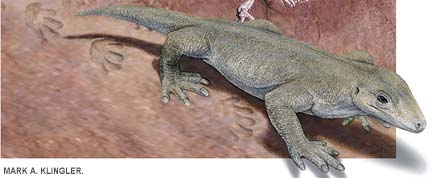
Two reptile-like animals living 290 million years ago are the oldest creatures to have their footprints positively identified after a fortuitous discovery allowed scientists to match fossils to preserved trackways.
Fossils of Diadectes absitus and Orobates pabsti were recently found in the Tambach Formation in central Germany. Nearby and in the same sediment layer, scientists found well-preserved footprints made by creatures that plodded through the region's soft sediments long ago. The footprints turned out to be a match for the fossil animals.
The work, detailed in the latest issue of the Journal of Vertebrate Paleontology, marks the first footprints of the Paleozoic Era, a time before the dinosaurs that lasted from 540 to 240 million years ago, to be associated with the animals that made them. It could also force scientists to rethink how the ancient creatures moved.
Because of the exceptional preservation of the Tambach skeletons, scientists were able to match them to the nearby footprints. The two species were among the first four-legged plant eaters on land and have no close living relatives.
"Fossils don't usually include really good feet," said study team member David Berman of the Carnegie Museum of Natural History in Pittsburgh. "It's rare that we get feet with all the toe and wrist and ankle bones [intact]."
O. pabsti is a completely new species that has never been described before. "It's a new genus and species," Berman told LiveScience.
The new findings could allow scientists to partially recreate the migration patterns of these long-extinct creatures. "It is not necessary to find the skeleton of a creature at a certain locality to state that this animal has lived there," said Sebastian Voigt, a trackway expert from the Freiberg University of Mining and Technology in Germany.
Sign up for the Live Science daily newsletter now
Get the world’s most fascinating discoveries delivered straight to your inbox.
The work could also lead to a rethinking of how some of the first land creatures stood and walked. Mammals tend to have limbs that drop vertically from the pelvis to the ground, while those of reptiles tend to extend away from the body horizontally before turning back downward. The new reptiles had a "mammalian" arrangement for their limbs.
"We know from the trackways that these animals had their feet planted almost under their body," Berman said, "whereas in textbooks, they give them a sprawling gait as if the limbs are extended out from the body considerably. This just isn't true. You look at the trackway and you see that the footprints are very close to the midline of the body."









